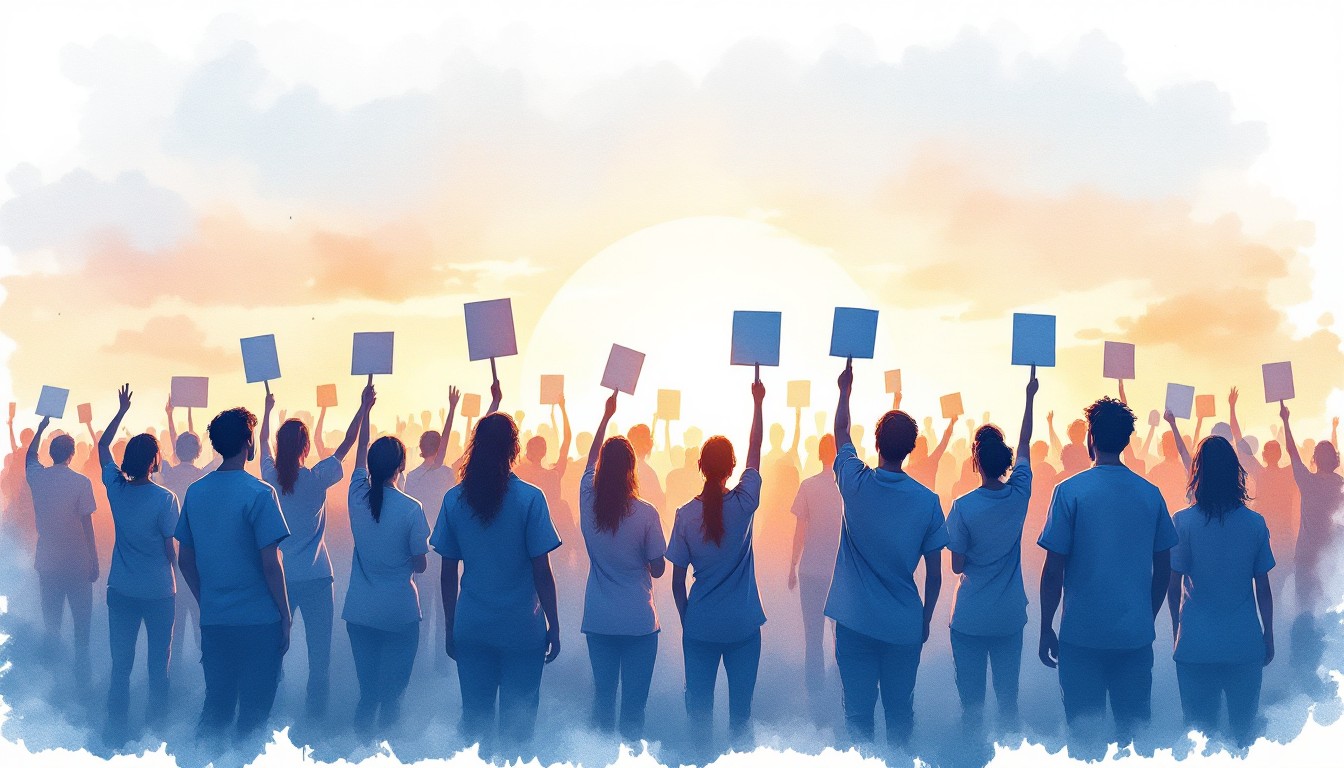An Interview with Amanda Norris, DO
In October 2023, hundreds of physicians (many of whom are family doctors) employed by Allina Health voted to be represented by a union, Doctors Council SEIU Local 10MD. Among 589 eligible voters, 325 voted for the labor union and 200 voted against. The National Labor Relations Board officially certified the union soon after the vote. It is believed to be the largest group of unionized private-sector physicians in the country.
Minnesota Academy of Family Physician (MAFP) member Amanda Norris, DO, shares about her role in organizing and advocacy around the unionization process, how personal relationships make a difference and why it’s important for physicians to be advocates for themselves as well as their patients.

WHY UNIONIZE PHYSICIANS?
Health care has changed significantly over the last decade. Gone are the days of physician-owned hospitals and practices. What’s left are large corporations deciding how we practice medicine. Initially, it was easier to just see our patients and ignore the other parts. We let it slide when our administrators did not (or could not) amplify our ideas due to the constraints of corporate medicine. We were told how to practice medicine, what our quality goals should be and what our monetary worth was by people who had much less patient contact time than we did. And we had no say.
The pandemic brought to the surface plummeting physician well-being and numerous safety concerns. Medicine felt no longer mentally or physically safe. We decided it was our ethical obligation to ourselves and our patients to act. Before the unionization process really got going, several of my clinician colleagues attempted to discuss their concerns with high-level leadership. Unfortunately, they were told to “stay in their lane or go somewhere else.” Thus, the unionization process was born.
At the crux of all of this, we strongly believe health care can thrive again. If we did not, we would have left medicine, and this work would have ended long ago. The mission statement driving us is “We believe the patient-clinician relationship must be the center of health care. Our mission as a union of primary and urgent care clinicians is to advocate for excellent care as unique as our patients. We stand together to ensure we have the resources necessary for a safe, collaborative and sustainable work environment. As members of Doctors Council, we will work with the Allina administration to improve the lives of our patients, care teams and communities.”
WHAT ARE THE GOALS OF THE UNION?
Our union’s official goals are currently being defined through a bargaining survey. This is as close to a democracy as we can hope for in health care. Every member’s voice carries equal weight. We will know more in the coming weeks as survey results are reviewed.
Broadly, we dream for a better tomorrow, with checks and balances to the corporate interests at work, flexibility across clinics, work-life balance, the ability to advocate for our patients and true contracts with floors and not ceilings.
ANY LEARNINGS TO SHARE ON ORGANIZING?
Personal relationships are very important. A powerful lesson learned in residency was the importance of connecting with not only patients, but physician colleagues at all levels of training. Medical students and residents one day become partners.
It was largely through relationships that we were successful in our grassroots unionizing. One conversation at a time, we got the numbers we needed to be successful over a 15-month period.
WHAT HAS YOUR ROLE BEEN IN THIS PROCESS?
A family doctor friend of a family doctor friend knew I was feeling frustrated, powerless and alone in my situation and connected me to the organizers from the Doctors Council. From there, we had our first meeting with interested clinicians in a garage. Not sure you can get more grassroots than that!
I grew up in a two-union-member household, with my mother a teacher and dad a nurse. The idea of being in a union was anything but scary to me, and I was willing to become part of our Organizing Committee early on.
Our Organizing Committee was filled with clinicians from a variety of backgrounds who agreed to be leaders in the process. This was such a deeply important process to me on so many levels. Around the time we started organizing, I had just seen the aftermath of several physicians who died by suicide in the Minnesota physician community, including one at Allina who had graduated from my medical school. People were literally dying because of this job, and I had to do something to help change it.
As part of the Organizing Committee, I helped connect other clinicians at Allina. I spent countless hours doing lots of phone calls, lunches, dinners, texts and emails to answer questions and dispel myths. I also helped compose educational materials, put up flyers and acted as a sounding board during our meetups with other clinicians and Doctors Council organizers. I like to think my best addition to the process was being a cheerleader when momentum would slow.
ARE YOU INVOLVED IN OTHER ADVOCACY/OUTREACH?
I am currently dabbling in literacy advocacy. I listened to the podcast “Sold a Story,” by Emily Hanford, and learned how literacy education in America is significantly harming kids’ ability to learn to read by continuing outdated and debunked literacy techniques. This leads to increased rates of depression and anxiety in kids and teens as well as poor health literacy in adulthood.
I have written letters to members of my local school board and representatives and joined a literacy advocacy group in my district to attempt to help. Literacy is a social determinant of health and is directly in our lane as doctors.
WHY IS IT IMPORTANT FOR PHYSICIANS TO BE ADVOCATES FOR THEMSELVES?
The high levels of burnout and moral injury experienced by family doctors is nothing new to those of us practicing. We see it daily—we watch our partners and families suffer as we suffer. There are a million factors affecting these things. One thing we know for sure is that the resiliency of a family doctor is not the problem. A resiliency program or training is not what we need. We need to retake control of our practices and lives.
The saying goes: “Put your own oxygen mask on before helping others.” Family doctors have been trying to help others get their masks on for years without putting one on themselves, and we are suffocating. Family physicians need appropriate support and benefits to allow us to first care for ourselves. Once this happens, we can best care for our patients.
One voice alone fighting for change gets drowned out, but a collective voice of nearly 600 clinicians is not easy to ignore. Our great hope is that our effort will inspire other groups to do the same, and then we can band together to advocate for health care change.
ANYTHING ELSE YOU’D LIKE TO SHARE?
This process has been rewarding for me and many others, largely because now we know that we are not alone. It’s easy to get wrapped up in all the things you need to do as a family doctor. We rarely had the chance to share the good and bad of our clinics or the practice of medicine. This social support was a key piece to what we were missing. Through the unionization effort, we had so many in-person and virtual meetups. Through these connections, we received the support we were missing practicing in traditional corporate health care settings. I could feel my burnout and moral injury decreasing through the process as I felt my control returning.
We have a WhatsApp group that continues to be a great way to share ideas for improvement, frustrations and successes. We have already seen innovative ideas be shared throughout Allina and practices get changed in a positive way that saves money.
We will continue to not be alone as we move forward together into the bargaining process, in an effort to improve patient care as well as our wellbeing and longevity to practice this rewarding and difficult calling.
Questions or want to learn more about organizing or the Doctors Council? Email Norris at akkern@gmail.com or go to www.doctorscouncil.org.



